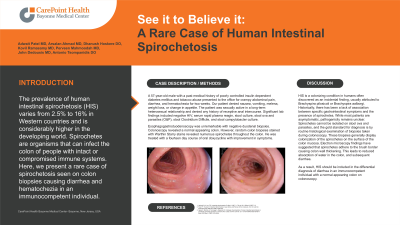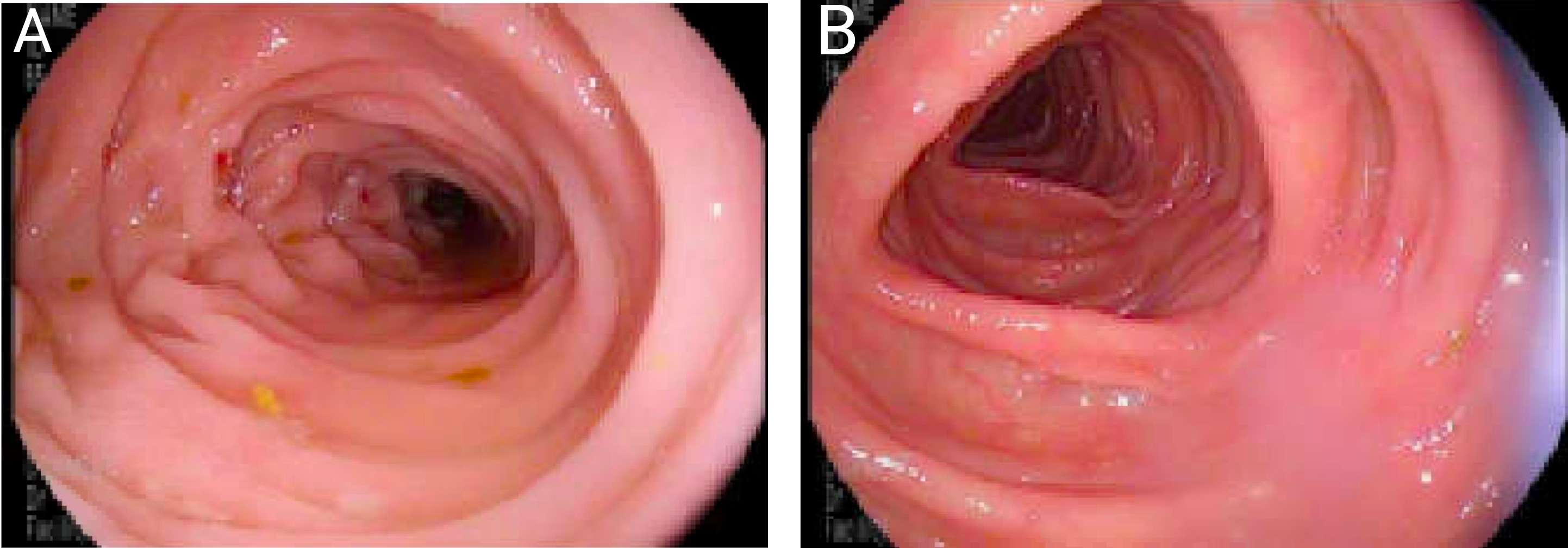Sunday Poster Session
Category: Colon
P0310 - See It to Believe It: A Rare Case of Human Intestinal Spirochetosis
Sunday, October 22, 2023
3:30 PM - 7:00 PM PT
Location: Exhibit Hall

Has Audio
.jpg)
Adwait Patel, MD
Bayonne Medical Center
BAYONNE, NJ
Presenting Author(s)
Adwait Patel, MD1, Arsalan Ahmad, MD2, Dhanush Hoskere, DO3, Kovil Ramasamy, MD2, Mahmoodah Perveen, MD2, John Dedousis, MD4, Antonio Tsompanidis, DO4
1Bayonne Medical Center, Harrison, NJ; 2Bayonne Medical Center - CarePoint Health, Bayonne, NJ; 3CarePoint Health, Bayonne, NJ; 4Bayonne Medical Center, Bayonne, NJ
Introduction: The prevalence of human intestinal spirochetosis (HIS) varies from 2.5% to 16% in Western countries and is considerably higher in the developing world. Spirochetes are organisms that can infect the colon of people with intact or compromised immune systems. Here, we present a rare case of spirochetosis seen on colon biopsies causing diarrhea and hematochezia in an immunocompetent individual.
Case Description/Methods: A 57-year-old male with past medical history of poorly controlled insulin dependent diabetes mellitus and tobacco abuse presented to the office for crampy abdominal pain, diarrhea, and hematochezia for two weeks. Our patient denied nausea, vomiting, melena, weight loss, or change in appetite. The patient was sexually active in a long‐term heterosexual relationship and denied any history of receptive anal intercourse. Significant lab findings included negative HIV, serum rapid plasma reagin, stool culture, stool ova and parasites (O&P), stool Clostridium Difficile, and stool campylobacter culture. Esophagogastroduodenoscopy was unremarkable with negative duodenal biopsies. Colonoscopy revealed a normal appearing colon. However, random colon biopsies stained with Warthin Starry stain revealed numerous spirochetes throughout the colon. He was treated with a fourteen day course of oral doxycycline with improvement in symptoms.
Discussion: HIS is a colonizing condition in humans often discovered as an incidental finding, usually attributed to Brachyspira pilosicoli or Brachyspira aalborgi. Historically, there has been a lack of association between specific gastrointestinal symptoms and the presence of spirochetes. While most patients are asymptomatic, pathogenicity remains unclear. Spirochetes cannot be isolated on stool ova and parasite, and the gold standard for diagnosis is by routine histological examination of biopsies taken during colonoscopy. These biopsies generally display colonization of the spirochetes on the surface of the colon mucosa. Electron microscopy findings have suggested that spirochetes adhere to the brush border causing colon wall thickening. This leads to reduced absorption of water in the colon, and subsequent diarrhea. As a result, HIS should be included in the differential diagnosis of diarrhea in an immunocompetent individual with a normal appearing colon on colonoscopy.

Disclosures:
Adwait Patel, MD1, Arsalan Ahmad, MD2, Dhanush Hoskere, DO3, Kovil Ramasamy, MD2, Mahmoodah Perveen, MD2, John Dedousis, MD4, Antonio Tsompanidis, DO4. P0310 - See It to Believe It: A Rare Case of Human Intestinal Spirochetosis, ACG 2023 Annual Scientific Meeting Abstracts. Vancouver, BC, Canada: American College of Gastroenterology.
1Bayonne Medical Center, Harrison, NJ; 2Bayonne Medical Center - CarePoint Health, Bayonne, NJ; 3CarePoint Health, Bayonne, NJ; 4Bayonne Medical Center, Bayonne, NJ
Introduction: The prevalence of human intestinal spirochetosis (HIS) varies from 2.5% to 16% in Western countries and is considerably higher in the developing world. Spirochetes are organisms that can infect the colon of people with intact or compromised immune systems. Here, we present a rare case of spirochetosis seen on colon biopsies causing diarrhea and hematochezia in an immunocompetent individual.
Case Description/Methods: A 57-year-old male with past medical history of poorly controlled insulin dependent diabetes mellitus and tobacco abuse presented to the office for crampy abdominal pain, diarrhea, and hematochezia for two weeks. Our patient denied nausea, vomiting, melena, weight loss, or change in appetite. The patient was sexually active in a long‐term heterosexual relationship and denied any history of receptive anal intercourse. Significant lab findings included negative HIV, serum rapid plasma reagin, stool culture, stool ova and parasites (O&P), stool Clostridium Difficile, and stool campylobacter culture. Esophagogastroduodenoscopy was unremarkable with negative duodenal biopsies. Colonoscopy revealed a normal appearing colon. However, random colon biopsies stained with Warthin Starry stain revealed numerous spirochetes throughout the colon. He was treated with a fourteen day course of oral doxycycline with improvement in symptoms.
Discussion: HIS is a colonizing condition in humans often discovered as an incidental finding, usually attributed to Brachyspira pilosicoli or Brachyspira aalborgi. Historically, there has been a lack of association between specific gastrointestinal symptoms and the presence of spirochetes. While most patients are asymptomatic, pathogenicity remains unclear. Spirochetes cannot be isolated on stool ova and parasite, and the gold standard for diagnosis is by routine histological examination of biopsies taken during colonoscopy. These biopsies generally display colonization of the spirochetes on the surface of the colon mucosa. Electron microscopy findings have suggested that spirochetes adhere to the brush border causing colon wall thickening. This leads to reduced absorption of water in the colon, and subsequent diarrhea. As a result, HIS should be included in the differential diagnosis of diarrhea in an immunocompetent individual with a normal appearing colon on colonoscopy.

Figure: A) normal appearing descending colon
B) normal appearing transverse colon
B) normal appearing transverse colon
Disclosures:
Adwait Patel indicated no relevant financial relationships.
Arsalan Ahmad indicated no relevant financial relationships.
Dhanush Hoskere indicated no relevant financial relationships.
Kovil Ramasamy indicated no relevant financial relationships.
Mahmoodah Perveen indicated no relevant financial relationships.
John Dedousis indicated no relevant financial relationships.
Antonio Tsompanidis indicated no relevant financial relationships.
Adwait Patel, MD1, Arsalan Ahmad, MD2, Dhanush Hoskere, DO3, Kovil Ramasamy, MD2, Mahmoodah Perveen, MD2, John Dedousis, MD4, Antonio Tsompanidis, DO4. P0310 - See It to Believe It: A Rare Case of Human Intestinal Spirochetosis, ACG 2023 Annual Scientific Meeting Abstracts. Vancouver, BC, Canada: American College of Gastroenterology.
